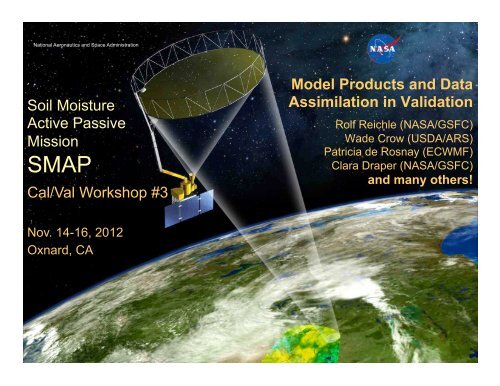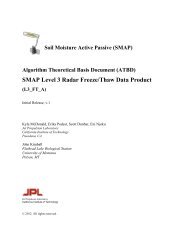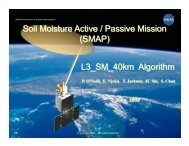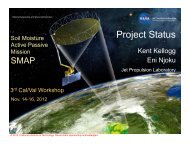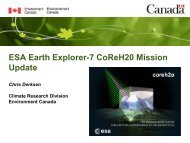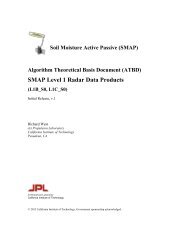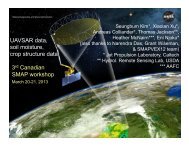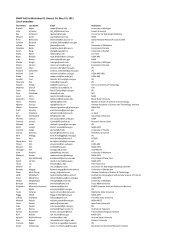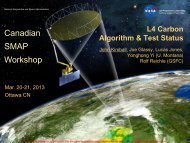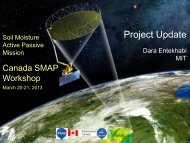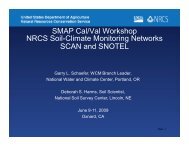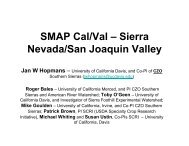7. Model Products and Data Assimilation in Validation - SMAP - NASA
7. Model Products and Data Assimilation in Validation - SMAP - NASA
7. Model Products and Data Assimilation in Validation - SMAP - NASA
You also want an ePaper? Increase the reach of your titles
YUMPU automatically turns print PDFs into web optimized ePapers that Google loves.
National Aeronautics <strong>and</strong> Space Adm<strong>in</strong>istration<br />
<strong>SMAP</strong> CalVal Workshop #3 – Oxnard, Nov 14-16, 2012<br />
Soil Moisture<br />
Active Passive<br />
Mission<br />
<strong>SMAP</strong><br />
Cal/Val Workshop #3<br />
<strong>Model</strong> <strong>Products</strong> <strong>and</strong> <strong>Data</strong><br />
<strong>Assimilation</strong> <strong>in</strong> <strong>Validation</strong><br />
Rolf Reichle (<strong>NASA</strong>/GSFC)<br />
Wade Crow (USDA/ARS)<br />
Patricia de Rosnay (ECWMF)<br />
Clara Draper (<strong>NASA</strong>/GSFC)<br />
<strong>and</strong> many others!<br />
Nov. 14-16, 2012<br />
Oxnard, CA<br />
<strong>Model</strong> products <strong>and</strong> data assimilation <strong>in</strong> validation
Outl<strong>in</strong>e<br />
Direct comparisons vs. model products<br />
Classical metrics<br />
Bias, RMSD, R<br />
Triple colocation<br />
<strong>Validation</strong> with<strong>in</strong> data assimilation systems<br />
Monitor<strong>in</strong>g<br />
Observations-m<strong>in</strong>us-forecast residuals <strong>and</strong> other stats<br />
Improvements from data assimilation<br />
Use of related observations (vegetation, precipitation, …)
Outl<strong>in</strong>e<br />
Direct comparisons vs. model products<br />
Classical metrics<br />
Bias, RMSD, R<br />
Triple colocation<br />
<strong>Validation</strong> with<strong>in</strong> data assimilation systems<br />
Monitor<strong>in</strong>g<br />
Observations-m<strong>in</strong>us-forecast residuals <strong>and</strong> other stats<br />
Improvements from data assimilation<br />
Use of related observations (vegetation, precipitation, …)
Direct Comparisons: Classical Metrics<br />
<strong>Model</strong> products are not “truth”.<br />
However, NWP-type “model” products are based on many<br />
millions of atmospheric observations each day.<br />
Skill of “model” soil moisture products is often comparable<br />
to or even better than that of satellite retrievals.<br />
Skill vs. ~200 <strong>in</strong> situ sites ECMWF ASCAT SMOS<br />
Correlation 0.70 0.53 0.54<br />
Bias (<strong>in</strong>dex) -0.05 -0.07 0.12<br />
RMSD (<strong>in</strong>dex) 0.24 0.26 0.24<br />
Caveat:<br />
Early<br />
results!<br />
Albergel et al., RSE 2012
Direct Comparisons: Classical Metrics<br />
Corr. coeff. (SMOS vs. ECMWF)<br />
Corr. coeff. (SMOS vs. SCAN)<br />
Albergel et al., RSE 2012<br />
Corr. coeff. (ASCAT vs. ECMWF)<br />
Benefit:<br />
Global assessment vs.<br />
<strong>in</strong>dependent estimates<br />
(as opposed to a<br />
h<strong>and</strong>ful of locations)<br />
Gruhier et al, H-SAF VS11_02:<br />
http://www.ecmwf.<strong>in</strong>t/research/EUMETSAT_projects/<br />
SAF/HSAF/ecmwf-hsaf/<strong>in</strong>dex.html
Outl<strong>in</strong>e<br />
Direct comparisons vs. model products<br />
Classical metrics<br />
Bias, RMSD, R<br />
Triple Colocation<br />
<strong>Validation</strong> with<strong>in</strong> data assimilation systems<br />
Monitor<strong>in</strong>g<br />
Observations-m<strong>in</strong>us-forecast residuals <strong>and</strong> other stats<br />
Improvements from data assimilation<br />
Use of related observations (vegetation, precipitation, …)
Direct Comparisons:Triple Colocation<br />
Triple Colocation (TC) is a method to estimate RMS errors <strong>in</strong><br />
data products.<br />
TC requires three <strong>in</strong>dependent estimates.<br />
<strong>Model</strong> products can be used for TC.<br />
NOTE:<br />
1.) TC cannot provide absolute RMS errors.<br />
2.) TC is sensitive to the climatology of the reference data set.<br />
3.) Error correlations between data sets result <strong>in</strong> biased RMSE<br />
estimates.
Direct Comparisons:Triple Colocation<br />
Variability (anomalies)<br />
RMSE of ASCAT<br />
Fractional RMSE<br />
ASCAT<br />
[Ref dataset = ASCAT]<br />
ASCAT<br />
AMSR-E<br />
GEOS-5<br />
[Ref dataset = AMSR-E]<br />
[Ref dataset = GEOS-5]<br />
AMSR-E<br />
Estimated RMSE<br />
reflects variability of<br />
reference product.<br />
Use fractional RMSE<br />
<strong>in</strong>stead.<br />
Draper et al. 2012 <strong>in</strong> prep.
Direct Comparisons:Triple Colocation<br />
TC-based estimates match coresite<br />
based estimates of RMSE.<br />
Crow et al. 2012 IAHS Red Book #352<br />
Bias between RMSE estimates is<br />
related to error correlations<br />
between data products.
Direct Comparisons:Triple Colocation<br />
TC-based fRMSE estimates are consistent with:<br />
• fRMSE from error propagation <strong>and</strong><br />
• expectations (vegetation classes).<br />
Draper et al.<br />
2012 <strong>in</strong> prep.
Outl<strong>in</strong>e<br />
Direct comparisons vs. model products<br />
Classical metrics<br />
Bias, RMSD, R<br />
Triple colocation<br />
<strong>Validation</strong> with<strong>in</strong> data assimilation systems<br />
Monitor<strong>in</strong>g<br />
Observations-m<strong>in</strong>us-forecast residuals <strong>and</strong> other stats<br />
Improvements from data assimilation<br />
Use of related observations (vegetation, precipitation, …)
Ensemble Kalman filter (EnKF)<br />
y k<br />
model<br />
propagation<br />
step<br />
update<br />
step
Diagnostics of filter performance<br />
Filter update: x + = x − + K(y – x − )<br />
K = P (P + R) −1 = Kalman ga<strong>in</strong><br />
Diagnostic: E[(y − x − ) (y – x − ) T ] = P + R<br />
x − = model forecast<br />
x + = “analysis”<br />
y = observation<br />
<strong>in</strong>novations ≡ obs – model prediction<br />
(<strong>in</strong>ternal diagnostic)<br />
state err cov + obs err cov<br />
(controlled by <strong>in</strong>puts)<br />
soil moisture<br />
−<br />
y-x<br />
x +<br />
y±<br />
x − ±<br />
R<br />
P<br />
time<br />
Innovations diagnostics are ALWAYS available with<strong>in</strong> assimilation system.<br />
• Mean of <strong>in</strong>novations should equal zero. Otherwise have bias!<br />
Example:<br />
1) Bias.<br />
2) Input uncerta<strong>in</strong>ties too small.<br />
• Normalize <strong>in</strong>novations with sqrt(P+R) ! std-dev should equal one.<br />
Otherwise (<strong>in</strong>put) model <strong>and</strong> obs error parameters are <strong>in</strong>consistent!
Outl<strong>in</strong>e<br />
Direct comparisons vs. model products<br />
Classical metrics<br />
Bias, RMSD, R<br />
Triple colocation<br />
<strong>Validation</strong> with<strong>in</strong> data assimilation systems<br />
Monitor<strong>in</strong>g<br />
Observations-m<strong>in</strong>us-forecast residuals <strong>and</strong> other stats<br />
Improvements from data assimilation<br />
Use of related observations (vegetation, precipitation, …)
ASCAT Monitor<strong>in</strong>g (Soil Moisture)<br />
http://www.ecmwf.<strong>in</strong>t/products/forecasts/d/charts/monitor<strong>in</strong>g/satellite/slmoist/ascat/<br />
Monitor<strong>in</strong>g of near-real time<br />
ASCAT data stream.<br />
System automatically generates<br />
graphics.<br />
ASCAT retrievals are scaled to<br />
the ECMWF model climatology<br />
(cdf-match<strong>in</strong>g).<br />
ECMWF<br />
ECMWF
ASCAT Monitor<strong>in</strong>g (Soil Moisture)<br />
<strong>in</strong>novations = first-guess departures = observations-m<strong>in</strong>us-forecast residuals<br />
Mean of <strong>in</strong>novations: 27 Sep to 27 Oct 2012<br />
(ASCAT m<strong>in</strong>us ECMWF surface soil moisture)<br />
m 3 m -3<br />
ASCAT retrievals are NOT<br />
assimilated <strong>in</strong>to the system.<br />
ECMWF<br />
ECMWF
ASCAT Monitor<strong>in</strong>g (Soil Moisture)<br />
Std-dev of <strong>in</strong>novations: 27 Sep to 27 Oct 2012<br />
m 3 m -3<br />
ASCAT retrievals are NOT<br />
assimilated <strong>in</strong>to the system.<br />
ECMWF<br />
ECMWF
ASCAT Monitor<strong>in</strong>g (Soil Moisture)<br />
Std-dev of observations: 27 Sep to 27 Oct 2012<br />
! Issue most likely related to observations.<br />
m 3 m -3<br />
ASCAT retrievals are NOT<br />
assimilated <strong>in</strong>to the system.<br />
ECMWF<br />
ECMWF
ASCAT Monitor<strong>in</strong>g<br />
Global scale statistics<br />
13 September 2011:<br />
Revised cdf-match<strong>in</strong>g.<br />
18 August 2011:<br />
Improved ASCAT product,<br />
more data pass QC for<br />
monitor<strong>in</strong>g.<br />
ECMWF<br />
ECMWF
ASCAT Monitor<strong>in</strong>g (Soil Moisture)<br />
April 2011 stats w/ old L2 processor <strong>and</strong> old cdf-match<strong>in</strong>g.<br />
First guess departures exhibit:<br />
• Angular dependency (problem: ASCAT product).<br />
• Positive bias (problem: cdf-match<strong>in</strong>g).<br />
First guess departure<br />
mean = 0.033 m 3 m -3<br />
std-dev = 0.090 m 3 m -3<br />
ECMWF<br />
<strong>in</strong>cidence angles<br />
large small large<br />
First guess departure<br />
ECMWF
ASCAT Monitor<strong>in</strong>g (Soil Moisture)<br />
April 2011 stats w/ new L2 processor <strong>and</strong> new cdf-match<strong>in</strong>g.<br />
First guess departures exhibit:<br />
• Improved angular signature.<br />
• Improved mean <strong>in</strong>novations.<br />
First guess departure<br />
mean = 0.017 m 3 m -3<br />
std-dev = 0.071 m 3 m -3<br />
ECMWF<br />
<strong>in</strong>cidence angles<br />
large small large<br />
First guess departure<br />
ECMWF
SMOS Monitor<strong>in</strong>g (Brightness Temperature)<br />
Std-dev of <strong>in</strong>novations: July/August 2012<br />
Monitor<strong>in</strong>g illustrates Radio Frequency Interference (RFI) issues.<br />
Many RFI sources switched off <strong>in</strong> Europe, still an important issue <strong>in</strong> Asia.<br />
SMOS TB are<br />
NOT assimilated<br />
<strong>in</strong>to the system.<br />
Muñoz Sabater et al., 2011<br />
ECMWF<br />
ECMWF
SMOS Monitor<strong>in</strong>g (Brightness Temperature)<br />
Std-dev of <strong>in</strong>novations: Sept/Oct 2012<br />
New RFI sources over Pol<strong>and</strong> impact<strong>in</strong>g Europe.<br />
More <strong>in</strong>fo at http://www.cesbio.ups-tlse.fr/SMOS_blog/<br />
SMOS TB are<br />
NOT assimilated<br />
<strong>in</strong>to the system.<br />
Muñoz Sabater et al., 2011<br />
ECMWF<br />
ECMWF
Outl<strong>in</strong>e<br />
Direct comparisons vs. model products<br />
Classical metrics<br />
Bias, RMSD, R<br />
Triple colocation<br />
<strong>Validation</strong> with<strong>in</strong> data assimilation systems<br />
Monitor<strong>in</strong>g<br />
Observations-m<strong>in</strong>us-forecast residuals <strong>and</strong> other stats<br />
Improvements from data assimilation<br />
Use of related observations (vegetation, precipitation, …)
<strong>Data</strong> <strong>Assimilation</strong><br />
Assimilat<strong>in</strong>g satellite retrievals <strong>in</strong>to the model provides<br />
additional evaluation options:<br />
1.) Validate assimilation product vs. soil moisture <strong>in</strong> situ obs.<br />
2.) Validate assimilation product vs. related observations.<br />
3.) Evaluate <strong>in</strong>novations <strong>and</strong> <strong>in</strong>crements (<strong>in</strong>cl. “R-value”<br />
approach).
Skill <strong>in</strong>creases significantly<br />
through data assimilation.<br />
Similar improvements from<br />
AMSR-E <strong>and</strong> ASCAT.<br />
<strong>Data</strong> assimilation<br />
Metric: Anom. time series corr. coeff.<br />
Anomalies ≡ mean seasonal cycle removed<br />
Validated with <strong>in</strong> situ data<br />
Draper et al. (2012), GRL, doi:10.1029/2011GL050655.
<strong>Data</strong> assimilation<br />
Rank correlations between soil moisture <strong>and</strong> NDVI (one-month lag)<br />
(left) without <strong>and</strong> (right) with assimilation of satellite soil moisture.<br />
Difference map<br />
(right m<strong>in</strong>us left)<br />
Large added value<br />
<strong>in</strong> areas with poor<br />
precipitation obs.<br />
Bolten <strong>and</strong> Crow (2012), GRL, doi:10.1029/2012GL053470.
<strong>Data</strong> assimilation<br />
“R-value” = (anti-)correlation between<br />
(i) analysis <strong>in</strong>crements (from an assimilation system us<strong>in</strong>g st<strong>and</strong>ard precip.) <strong>and</strong><br />
(ii) errors <strong>in</strong> precipitation (vs. high-quality estimates)<br />
“R-values” for 4 different AMSR-E<br />
soil moisture products<br />
“R-values” agree with skill<br />
assessed vs. <strong>in</strong> situ obs.<br />
Quantitative analysis of strengths<br />
<strong>and</strong> weaknesses of a given satellite<br />
product vs. other products.<br />
Crow et al. (2010), TGARS, doi:10.1109/TGRS.2010.2040481
<strong>Model</strong> products <strong>and</strong> assimilation for <strong>SMAP</strong> validation<br />
JPL/SDS:<br />
• Assessment of L2/L3 products vs. model products.<br />
GMAO/SDS:<br />
• Monitor<strong>in</strong>g of L4_SM.<br />
• Assessment of L4_C.<br />
Early Adopter projects (examples):<br />
• ECMWF: Monitor<strong>in</strong>g of L1C_TB <strong>and</strong> L2_SM_A.<br />
• Environment Canada: Impact of <strong>SMAP</strong> assimilation on NWP.<br />
• Army: Impact on <strong>SMAP</strong> assimilation on mobility estimates.<br />
• …
Summary<br />
Satellite products can be evaluated directly aga<strong>in</strong>st model<br />
products (<strong>in</strong>cl. Triple Colocation).<br />
Satellite products can be evaluated with<strong>in</strong> data assimilation<br />
systems (<strong>in</strong>cl. Monitor<strong>in</strong>g <strong>and</strong> R-value approach).<br />
<strong>Model</strong> products <strong>and</strong> data assimilation methods enable:<br />
• near-global evaluation,<br />
• cont<strong>in</strong>uous <strong>and</strong> near-real time assessment,<br />
• evaluation at the appropriate scale, <strong>and</strong><br />
• use of additional observations (e.g. precipitation, vegetation).<br />
<strong>Model</strong> products <strong>and</strong> assimilation systems are not perfect. Their<br />
use <strong>in</strong> evaluation only supplements core-site validation!
Thank you for your attention.<br />
Questions?
Back-Up Slides
Direct Comparisons: Classical Metrics<br />
Tsk<strong>in</strong> mean difference: GEOS-5 m<strong>in</strong>us GOES-13<br />
6z (night)<br />
18z (day)<br />
Scar<strong>in</strong>o et al., Rem Sens<br />
2012 (submitted)
L<strong>and</strong> surface temperature (LST) assimilation:<br />
Interpret<strong>in</strong>g <strong>in</strong>novations<br />
Mean of <strong>in</strong>novations [K]<br />
(CLSM only)<br />
Std-dev of norm.<br />
<strong>in</strong>novations [-]<br />
(CLSM only)<br />
Target<br />
value<br />
`<br />
without<br />
with<br />
a priori scal<strong>in</strong>g<br />
Without a priori scal<strong>in</strong>g,<br />
strong bias rema<strong>in</strong>s.<br />
`<br />
without<br />
with<br />
a priori scal<strong>in</strong>g<br />
Input model <strong>and</strong>/or obs<br />
error std-dev are too small.<br />
b0, b8:<br />
without/with<br />
dyn bias corr<br />
Reichle et al. (2010), JHM, doi:10.1175/2010JHM1262.1.


